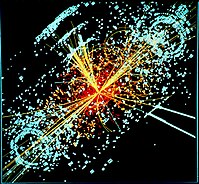
Photo from wikipedia
We investigate the implications on the dark matter (DM) signal from the AMS-02 cosmic antiproton flux. Global fits to the data are performed under different propagation and hadronic interaction models.… Click to show full abstract
We investigate the implications on the dark matter (DM) signal from the AMS-02 cosmic antiproton flux. Global fits to the data are performed under different propagation and hadronic interaction models. The uncertainties from the injection spectrum, propagation effects and solar modulation of the cosmic rays are taken into account comprehensively. Since we need to investigate extended parameter regions with multiple free parameters in the fit, the machine learning method is adopted to maintain a realistic time cost. We find all the effects considered in the fitting process interplay with each other, among which the hadronic interaction model is the most important factor affecting the result. In most hadronic interaction and CR propagation models no DM signal is found with significance larger than $2\sigma$ except that the EPOS-LHC interaction model requires a more than $3\sigma$ DM signal with DM mass around $1\,\mathrm{TeV}$. For the diffusive reacceleration propagation model there is a highly significant DM signal with mass around $100\,\mathrm{GeV}$. However, the signal becomes less than $1\sigma$ if we take a charge dependent solar modulation potential in the analysis.
Journal Title: Physical Review D
Year Published: 2019
Link to full text (if available)
Share on Social Media: Sign Up to like & get
recommendations!